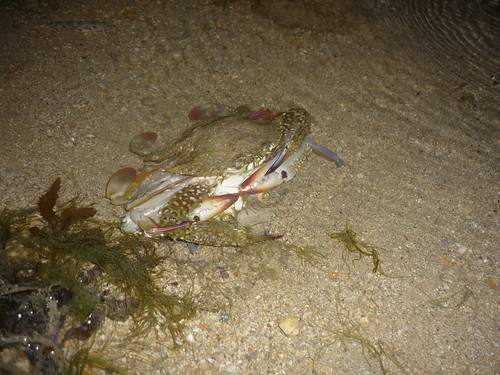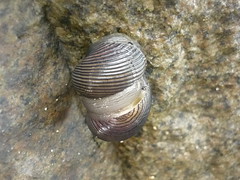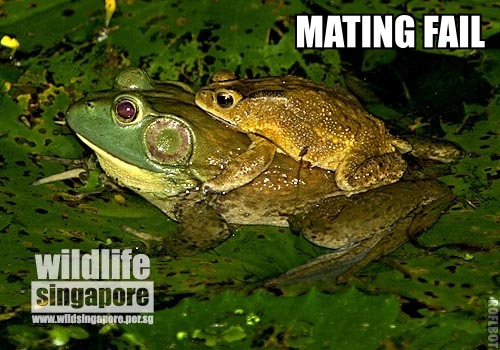
Flower crabs (Portunus pelagicus)
Pulau Subar Darat (Little Sister Island), 31st August 2008
Don't these two crabs look as if they're doing the waltz?
And if all goes well, here's what happens next:

Hot crab-on-crab action!
Here's a few other photos I've taken of various critters literally doing it 'like they do on the Discovery Channel'.


Left:American bullfrogs (Lithobates catesbeianus)
Khai Seng Trading & Fish Farm, 20th December 2008;
Right:Common sea star (Archaster typicus)
Cyrene Reef, 9th May 2008;


Left:Coastal horseshoe crabs (Tachypleus gigas)
Tanjung Rimau, 6th June 2008;
Right:Lined nerite (Nerita articulata)
Changi, 18th October 2008;
Before I continue, I have to apologise for conflating romance with sex, but as you're probably aware, the rest of the animal kingdom does not really share our notions of love and romance. For a great number of species, the act of courtship culminates in what is best summarised as 'Wham, bam, thank you ma'am'.
Though us prudish humans might not openly talk about sex, it cannot be denied that sexual reproduction has had an invaluable part to play in the evolution of life on this planet. If you think about it, almost everything about life on Earth has to do with sex. The staggering variety of life, both past and present, has come about partly due to species evolving their own adaptations to survive and reproduce. Many physical features, from the peacock's dazzling train of feathers, to the antlers of a stag, exist only for a sole purpose: to attract mates. The struggle between predator and prey essentially boils down to who gets to live long enough to reproduce and ensure the survival of one's genes. If a species fails to reproduce quickly enough to replace the individuals that die, it eventually becomes extinct. A great variety of animal behaviour is motivated by sex. Hell, much of the course of human history has been all about people moving into new lands and having sex with the locals. In fact, the common thread that unites a great deal of lifeforms is that they are all seeking to improve their chances of successfully reproducing. Asexual or parthenogenetic organisms are unique and interesting to us, precisely because they don't have sex. Even plants do it, just that their form of reproduction tends to be more subtle and often requires the intervention of other species.

(Image from The Perry Bible Fellowship)

In 1999, the BBC produced a 6-episode documentary series and accompanying book focusing on sexual reproduction in animals, entitled Battle of the Sexes in the Animal World. Snippets from the series have been uploaded to YouTube. The original narration has been dubbed over in Russian, although I think much of the footage speaks for itself. Here's one clip that really brings the point across: a great deal of intra-specific fighting occurs because of male competition to gain access to females.

Another book that discusses reproduction in animals is the witty and humorous Dr. Tatiana's Sex Advice to All Creation: The Definitive Guide to the Evolutionary Biology of Sex by Olivia Judson.

Gideon Defoe's How Animals Have Sex: A Guide to the Reproductive Habits of Creatures Great and Small is a decidedly tongue-in-cheek look from the perspective of a layman at some of the strange and often downright bizarre reproductive habits of other species.



Here's a few other books about animal reproduction which I haven't managed to get my hands on yet. These are A Natural History of Sex: The Ecology and Evolution of Mating Behavior by Adrian Forsyth, Promiscuity: An Evolutionary History of Sperm Competition by Tim Birkhead, and Sexual Selections: What We Can and Can't Learn About Sex from Animals by Marlene Zuk.

A very interesting book that deals with sexual behaviour of a rather different sort is Biological Exuberance: Animal Homosexuality and Natural Diversity by Bruce Bagemihl, which extensively discusses the prevalence of homosexual behaviour in a wide variety of animals.




Four books that explore reproduction from a more human perspective are Why Is Sex Fun?: The Evolution Of Human Sexuality by Jared Diamond, The Red Queen: Sex and the Evolution of Human Nature by Matt Ridley, Sperm Wars: Infidelity, Sexual Conflict, and Other Bedroom Battles by Robin Baker, and Bonk: The Curious Coupling of Science and Sex by Mary Roach.
I thought it would be appropriate to show the reproductive behaviour of some reptile species that can be found in Singapore. Many people are familiar with the mating displays of mammals and birds, but not many are aware of the fascinating displays of many reptiles.
Malayan water monitor (Varanus salvator)
Estuarine crocodile (Crocodylus porosus)
King cobra (Ophiophagus hannah)
I couldn't find any clips of reproductive behaviour in Singapore's native species of turtle, but to make up for it, here's a clip of tortoises mating:
Aldabra giant tortoise (Dipsochelys dussumieri) in Singapore Zoo
Tetrapod Zoology: Terrifying sex organs of male turtles
To conclude, it does get quite hilarious when animals get it wrong.

A male Asian toad (Duttaphrynus melanostictus) tries to get it on with a male American bullfrog (Lithobates catesbeianus).
(Original image from Wildlife Singapore)

Cane toad (Rhinella marinus) and... beer can?
(Original image from Terrapin Procrastination)
Tetrapod Zoology: Shocking inter-racial sex scenes
Now if you'll excuse me, I need to go read up more about the birds and the bees...